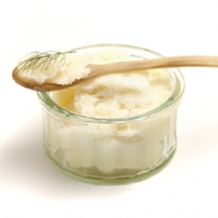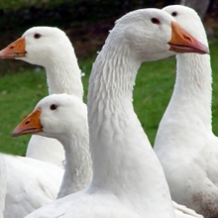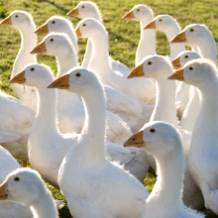Production
Production
What is the difference between domestic and commercially produced Goose Fat?
Essentially, it is the same product. When you cook a farmed goose at home, you will notice that a large amount of fat will drain off. You can collect and store this fat by pouring it through a fine sieve into a sterilized jar. Home-produced goose fat will keep for 2-3 months in the fridge. Commercially produced goose fat is produced in much the same way, just on a larger scale.
Are geese bred just for goose fat?
No. Goose meat is also highly-valued. In recent years, the traditional goose has been revived, with different cuts and whole birds winning favour with prominent chefs, restaurateurs and food writers (for further information visit www.goose.cc). Goose feathers are also a highly prized by-product, which are used to make top quality bedding and lightweight, insulated clothing.
I have seen Goose Fat in my local supermarket. Where will this have been produced?
The goose fat available in UK supermarkets and shops will probably have been sourced within the EU. The three most prominent goose breeding countries are France, Hungary and Poland. There is also a small artisan manufacturing industry in the UK.
How are geese reared?
Geese are reared on open countryside, enclosed with low-fencing. Geese are grazing animals and feed naturally on a diet of grass, grain and other seed crops.
I’ve read something about force-feeding. What is this?
Some, but not all goose-fat is produced from birds that have been reared specifically for the foie-gras industry, which is highly prized in some countries. If geese are reared for this purpose, they are force-fed to fatten their livers. After their initial free-range period (around 9 weeks) and treatment to assist in oesophagus dilation (eating grass, for example), food is deposited into the oesophagus via a slim metal or plastic feeding tube. The geese receive a diet of barley and water three times a day for 16 days, before being sent for slaughter. The meat, feathers, fat and other parts of the goose are still used in the same way as non force-fed goose.
How do I know that the geese have been ethically reared?
As with all food sold in the UK, traceability is a key issue. Supermarkets and suppliers will only source goose fat that can be fully traced back to individual farms and flocks. The supply chain is also audited before reaching the UK, to ensure that every stage in the process from farm to slaughter meets European welfare and hygiene standards. These standards include feeding, breeding, environment, management of the flocks, health, transport and slaughter.
How are the geese slaughtered?
Once fully grown (around 12 weeks), the geese are transported to a processing factory, where they are inspected to ensure that they are healthy. The geese are slaughtered according to EU approved standard poultry-killing methods.
How is the fat collected? Does it go through a particular process before being packed?
Goose Fat can be collected in a number of ways, including being drained off a roasted bird or being trimmed from whole birds and subsequently rendered down. Goose Fat, which is produced for the UK processors is cooled rapidly to prevent microbial growth, pumped into 20 kilo boxes and sealed prior to freezing. Once it reaches the UK, it is melted in large kettles to 90°C, cooled and then filled into jars or tubs.
What is the Shelf-life of Commercial Goose Fat?
Goose Fat has a long shelf-life usually in excess of 12 months. Once the jar has been opened, like home produced goose fat, it will keep for 2-3 months in the fridge.



